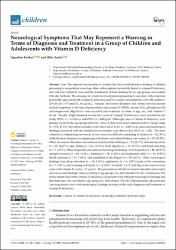| dc.description.abstract | Aim: This research was intended to evaluate the clinical and laboratory findings of children presenting to our pediatric neurology clinic with symptoms potentially linked to vitamin D deficiency and with low vitamin D levels and the distribution of those findings by sex, age groups, and vitamin D levels. Methods: This retrospective study involved patients presenting to our clinic with symptoms potentially associated with vitamin D deficiency and low serum concentrations of 25 OH vitamin D (25 OH D) (<75 nmol/L, 30 µg/mL). Patients’ movement disorders and central nervous system-related symptoms at the time of presentation and serum 25 OH D, calcium (Ca), phosphorus (P), and magnesium (Mg) levels were recorded and evaluated in terms of age, sex, and vitamin D levels. Results: Eight hundred twenty-two cases of vitamin D deficiency were included in the study, 50.2% (n = 413) boys and 49.8% (n = 409) girls. Although cases of vitamin D deficiency were present across all the age groups between 1 and 18, they were most common in the 5–14 age range (n = 372, 45.3%). Movement disorders were observed in 14.6% (n = 120) of our cases, and neurological findings associated with the central nervous system were observed in 52.6% (n = 432). The most common accompanying movement in our cases was difficulty remaining in balance (n = 42, 35%), while the most frequent accompanying central nervous system finding was vertigo (n = 99, 22.92%). Other movement disorders encountered included limb shaking (n = 32, 26.7%), abnormal posture (n = 20, 16.67%), easy falling (n = 16, 13.33%), body rigidity (n = 15, 12.5%), and hand clenching (n = 5, 4.17%). Other frequently encountered neurological findings were headache (n = 88, 20.37%), epileptic seizures (n = 83, 19.21%), fainting (n = 58, 13.43%), developmental delay (n = 41, 9.49%), febrile seizures (n = 33, 7.64%), and numbness in the fingers (n = 20, 4.63%). Other neurological findings were sleep disorders (n = 10, 2.31%), nightmares (n = 8, 1.85%), pain in the extremities (n = 7, 1.62%), and sweating and frailty (n = 4, 0.93% for both). Ca, P, and Mg levels were lower in cases with vitamin D levels < 12 µg/mL. The prevalences of both movement disorders and central nervous system findings varied according to age groups, sex, and vitamin D levels. Conclusions: Our study results show that vitamin D deficiency can present with different neurological findings and that these may vary according to age group, sex, and vitamin D levels. Clinicians must take particular care in pediatric cases with neurological findings in terms of the early diagnosis and treatment of vitamin D deficiency. | en_US |




















